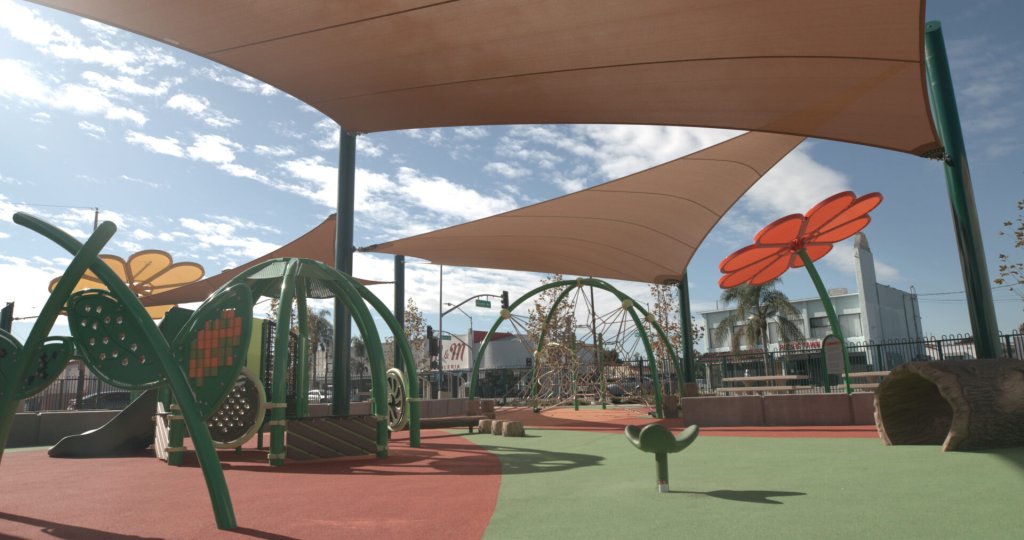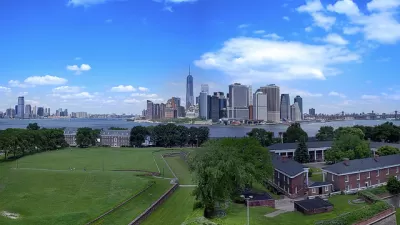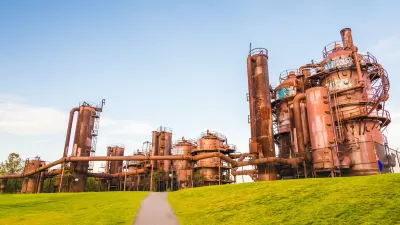Park creation can take decades of perseverance to overcome financial, regulatory, and social hurdles, but the end result for the local community is more than worth it.

When new parks open, we often see celebratory ribbon cuttings, smiling families, and pristine landscapes. But the tale rarely told is of the long, complex process it takes to reach that moment. Those of us who have worked on park projects like the recently opened Nogales Park in Walnut Park, Wishing Tree Park in West Carson, and San Gabriel River Park in Bassett know firsthand that creating a park involves much more than planting trees and installing playgrounds. It is a journey full of financial, regulatory, and social hurdles that require persistence, creativity, and collaboration to overcome.
As Los Angeles County Supervisor Janice Hahn explained at the opening ceremony for Nogales Park, “Everyone deserves access to safe, beautiful green spaces, especially in dense urban communities. But for years, Walnut Park has been denied that. Now we’ve turned what was an eyesore into a pocket park that this community will enjoy for years to come.” Her words highlight both the importance of parks as well as the time and resources needed to create them.
Park creation is far more complicated than most people realize. While the benefits of parks—spaces for recreation, relaxation, and environmental stewardship—are clear and well-documented, the path to developing these green spaces is filled with challenges.
Each new park represents a balancing act between logistical complexities and community needs. It takes generations to make sure green spaces are created and gifted to the public, remarked Norma E. García-González, director of L.A. County Department of Parks and Recreation (DPR), at the grand opening of San Gabriel River Park in June. “It is a story of perseverance,” she said.
So what are the biggest hurdles to park creation—and how can we overcome them?
1. Funding
One of the biggest hurdles is funding. Land acquisition, design, construction, and ongoing operations and maintenance require significant financial resources. Parks often compete with other pressing community needs for public dollars. Government budgets are typically stretched thin, and while grants and donations help, raising sufficient funds is a multiyear process that demands careful planning and tireless effort. Public-private partnerships can alleviate some financial burdens, but the process of securing these resources is time-consuming and requires a strategic approach.
For example, Wishing Tree Park, which took three decades and over $16 million to complete, relied on a variety of state, local, and other funding sources. Cynthia Babich, executive director of the Del Amo Action Committee, attributes the park’s opening to the “grit and tenacity” of the community, which continued pushing for green space despite these financial hurdles. “This is a victory in our quest for justice to the racist legacy that this community has endured for decades; a new beginning for this sacred spot so many died waiting for,” she said.

2. Regulatory red tape
Another obstacle is navigating the maze of regulations. A park project must go through several layers of government approvals, environmental assessments, and permitting processes, each of which can slow down progress and increase costs. While these steps are essential for transparency and the protection of communities, they often result in delays that make an already difficult process even more drawn out. For example, the ecological restoration and transformation of a former duck farm into the San Gabriel River Park took over 20 years due to numerous challenges, including regulatory and entitlement hurdles, but the end result balanced conservation with recreational use.
The Los Angeles Post quoted supervisor Hilda Solis, who has long championed green spaces in underserved areas, as saying this about San Gabriel River Park: “Today’s announcement represents the culmination of my 25-year mission to create vital open spaces in disadvantaged communities in the San Gabriel Valley... Now, everyone will have the access they deserve to an 80-acre urban oasis that will serve as an environmental crown jewel for generations to come. This is a moment to celebrate environmental justice and equity, because whenever we add open spaces in underserved communities, we improve the lives of thousands of children and families.”
Adding to the celebration of San Gabriel River Park, Mark Stanley, executive officer of the Watershed Conservation Authority, explained the broader vision of the park, stating, “The addition of this park is a huge, nature-based experience for the community and will be a destination site along the Emerald Necklace… further enhancing our natural areas and providing opportunity for all to engage in activities that are beneficial to our physical and mental health.”

3. Land acquisition
Land acquisition presents its own set of challenges, particularly in densely populated areas of Los Angeles County, where property values are high and suitable plots are hard to come by. According to DPR Director García-González, it took several attempts before the site for Nogales Park was acquired: “We tried to acquire the plot from three different owners who refused to sell this vacant land to the county, and we kept saying that the community needed a park. We finally got a call, and I believe we received that call because we kept insisting for ten years.”
In some cases, land previously used for industrial purposes requires costly remediation before it can be transformed into a public park. The development of Wishing Tree Park involved remediating one of the most contaminated sites in L.A. County. For much of the 20th century, the area was home to the Montrose Chemical Corp and a synthetic rubber plant, both of which left behind a legacy of contamination, including the dumping of hazardous waste and the disposal of benzene, propane, and butylene into unlined pits and evaporation ponds. These activities contaminated the soil and groundwater, causing severe health issues for residents, including cancers, autoimmune diseases, and respiratory problems.
Founded to address L.A.’s park inequities, the Los Angeles Neighborhood Land Trust (LANLT) played a pivotal role in making Wishing Tree Park a reality by acquiring the property, and designing and developing the park with substantial input from community members, while overcoming a variety of challenges in the process. As Tori Kjer, executive director of LANLT, explained, “This property was tricky. No one wanted it because of its history as a superfund site. The community has no parks nearby. Building a new park on the property is a step towards healing from past and current environmental trauma.”

4. Community engagement
Engaging with the community is both crucial and challenging to park development. Different residents often have conflicting ideas about what they want from a park; some may prioritize sports facilities like soccer fields or pickleball courts, while others prefer quiet, green spaces for relaxation. Reaching a consensus that meets the needs of all stakeholders, particularly underserved and marginalized groups, requires extensive dialogue and compromise. A park’s success hinges on local buy-in and participation.
Reflecting on the importance of Nogales Park, Salvador Diaz, a Walnut Park resident and community organizer, told La Opinión, “We finally see the fruits of our efforts and want to thank the entire community and the government for making this beautiful park a reality for Walnut Park” (translated from Spanish).
5. Stakeholder collaboration
The creation of parks requires collaboration among government agencies, non-profit organizations, and community activists. Each brings different resources and perspectives to the table. Overcoming the financial and regulatory barriers is often only possible when these entities work together. Government bodies provide institutional support, non-profits offer community-focused insights, and activists ensure the parks truly serve the needs of the people who will use them.
Community activism plays a crucial role. Often, it is the residents themselves who push for new parks, especially in underserved neighborhoods where green spaces are scarce.
Activists work tirelessly to highlight the social, environmental, and health benefits of parks, and their grassroots efforts often galvanize public support. Many recent parks in L.A. County were created in response to advocacy from local residents and organizations in high-need and vulnerable areas identified in the countywide Parks Needs Assessments prepared by DPR in 2016 and 2022.
Supervisor Holly Mitchell highlighted the importance of advocacy when she spoke about Wishing Tree Park, stating, "We are proud to officially open Wishing Tree Park. This moment is the culmination of over thirty years of advocacy by community members and dedication from our L.A. County Parks Department to bring much-needed green space to the unincorporated West Carson area.” Her remarks also speak to the significance and broader impact of reclaiming the contaminated site for community use.
6. Government policies and budgets
Beyond grassroots movements, policy changes and increased funding are another essential element to achieving broader goals of park equity and environmental justice.
Measures like L.A. County’s Measure A, Proposition 68, and the proposed Proposition 4 - Climate Bond are crucial in providing much-needed funds to support park creation, climate resilience, and environmental justice efforts.
Additionally, policy reforms that make it easier to restore and regenerate degraded land into parks can be game-changers. Streamlining land remediation processes and offering incentives to convert brownfields into green spaces could speed up park development, especially in communities that need them most.
The process of park creation is inherently complex, filled with financial constraints, regulatory hurdles, land acquisition issues, and community engagement challenges. Despite these obstacles, the benefits of creating parks for communities are undeniable. Parks are essential for advancing sustainability and promoting environmental justice and equity, providing critical spaces for recreation, connection, and well-being. Partnerships and community activism are critical to overcoming these challenges, but policy changes and sustained funding are equally vital to ensuring the future success of park development efforts.
Setting the stage for more green spaces
As we celebrate each new park opening, it is important to recognize the individuals and partnerships that made these spaces a reality, and the hidden triumphs over the challenges they faced along the way. With continued support through policy reforms and funding initiatives, we can expand the reach of green spaces and ensure they benefit all communities, especially those most in need. Through collaborative efforts and strong policies, we can create parks that promote health, well-being, and a sense of community for generations to come.
Clement Lau is a planner with over 17 years of park planning experience in Los Angeles County. He is a regular contributor to the National Recreation and Park Association (NRPA)'s Parks & Recreation magazine and Open Space blog.

Calculating the Benefits of Parks, Trails, and Open Space

History of U.S. Landscape Architecture, Part 1

Maui's Vacation Rental Debate Turns Ugly
Verbal attacks, misinformation campaigns and fistfights plague a high-stakes debate to convert thousands of vacation rentals into long-term housing.

Planetizen Federal Action Tracker
A weekly monitor of how Trump’s orders and actions are impacting planners and planning in America.

San Francisco Suspends Traffic Calming Amidst Record Deaths
Citing “a challenging fiscal landscape,” the city will cease the program on the heels of 42 traffic deaths, including 24 pedestrians.

Bend, Oregon Zoning Reforms Prioritize Small-Scale Housing
The city altered its zoning code to allow multi-family housing and eliminated parking mandates citywide.

Amtrak Cutting Jobs, Funding to High-Speed Rail
The agency plans to cut 10 percent of its workforce and has confirmed it will not fund new high-speed rail projects.

LA Denies Basic Services to Unhoused Residents
The city has repeatedly failed to respond to requests for trash pickup at encampment sites, and eliminated a program that provided mobile showers and toilets.
Urban Design for Planners 1: Software Tools
This six-course series explores essential urban design concepts using open source software and equips planners with the tools they need to participate fully in the urban design process.
Planning for Universal Design
Learn the tools for implementing Universal Design in planning regulations.
planning NEXT
Appalachian Highlands Housing Partners
Mpact (founded as Rail~Volution)
City of Camden Redevelopment Agency
City of Astoria
City of Portland
City of Laramie






























